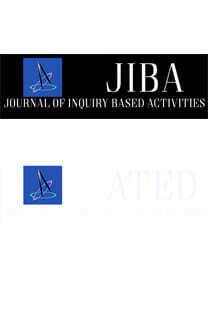REHBERLİ ARAŞTIRMA-SORGULAMA YAKLAŞIMINA UYGUN WEB DESTEKLİ FEN MATERYALİ GELİŞTİRİLMESİ: KEMİKLER
DEVELOPING WEB-ASSISTED SCIENCE MATERIAL BASED ON GUIDED INQUIRY APPROACH: BONES
___
- Akpullukçu, S., & Günay, Y. (2013). Fen ve teknoloji dersinde araştırmaya dayalı öğrenme ortamının öğrencilerin akademik başarı, hatırda tutma düzeyi ve tutumlarına etkisi. Ege Eğitim Dergisi, 14(1), 67-89.
- Alake-Tuenter, E., Biemans, H. J., Tobi, H., Wals, A. E., Oosterheert, I., & Mulder, M. (2012). Inquiry-based science education competencies of primary school teachers: A literature study and critical review of the American National Science Education Standards. International Journal of Science Education, 34(17), 2609-2640.
- Capps, D. K., & Crawford, B. A. (2013). Inquiry-based professional development: What does it take to support teachers in learning about inquiry and nature of science? International Journal of Science Education, 35(12), 1947-1978.
- Colburn, A. (2000). An inquiry primer. Science Scope, 23(6), 42-44.
- Colburn, A. (2004). Inquiring scientists want to know. Educational Leadership, 62, 63-67.
- Çalışkan, H. (2008). Eğitimcilerin araştırmaya dayalı öğrenme yaklaşımıyla ilgili algıları. Gazi Eğitim Fakültesi Dergisi, 28(1), 153-170.
- Çepni, S., Akdeniz, A. R., & Keser, Ö. F. (2000). Fen bilimleri öğretiminde bütünleştirici öğrenme kuramına uygun örnek rehber materyallerin geliştirilmesi. 19. Fizik Kongreside sunuldu, Fırat Üniversitesi, Elazığ, Türkiye.
- Çepni, S. (2018). Araştırma ve proje çalışmalarına giriş. Trabzon: Celepler Maatbaacılık.
- Gaddis, B. A., & Schoffstall, A. M., (2007). Incorporating guided-inquiry learning into the organic chemistry laboratory. Journal of Chemical Education, 84(5), 848-851.
- Hakverdi-Can, M., & Sönmez, D. (2012). Learning how to design a technology supported inquiry-based learning environment. Science Education International, 23(4), 338-352.
- Hall, I., & Higgins, S. (2005). Primary school students' perceptions of interactive whiteboards. Journal of Computer Assisted Learning, 21(2), 102-117.
- Hill, O. R. (2008). Computer assisted inquiry based learning in undergraduate science education (Unpublished master’s thesis). The Universtity of Texas at Dallas, Texas.
- Jin, G., & Bierma, T. J. (2011). Guided-inquiry learning in environmental health. Journal of Environmental Health, 73(6), 80.
- Karamustafaoğlu, O., & Kaya, M. (2013). Eğitsel oyunlarla ‘yansıma ve aynalar’ konusunun öğretimi: Yansımalı koşu örneği. Araştırma Temelli Etkinlik Dergisi, 3(2), 41-49.
- Kubicek, J. P. (2005). Inquiry-based learning, the nature of science, and computer technology: New possibilities in science education. Canadian Journal of Learning and Technology, 31(1), 51-58.
- Kuhlthau, C. C. (2010). Guided inquiry: School libraries in the 21st century. School Libraries Worldwide, 16(1), 1-12.
- Levy, P., Aiyegbayo, O., & Little, S. (2009). Designing for inquiry-based learning with the Learning Activity Management System. Journal of Computer Assisted Learning, 25(3), 238-251.
- Llewellyn, D. (2014). Inquiry within: Implementing inquiry- based science standards. USA: Corwinn Press, Inc.
- Maaß, K., & Artigue, M. (2013). Implementation of inquiry-based learning in day-to-day teaching: A synthesis. ZDM Mathematics Education, 45(6), 779-795.
- Melis, E., Andres, E., Budenbender, J., Frischauf, A., Goduadze, G., Libbrecht, P., ... Ullrich, C. (2001). ActiveMath: A generic and adaptive web-based learning environment. International Journal of Artificial Intelligence in Education, 12, 385-407.
- Milli Eğitim Bakanlığı. (2013). İlköğretim kurumları (ilkokullar ve ortaokullar) fen bilimleri dersi (3, 4, 5, 6, 7 ve 8. sınıflar) öğretim programı. Ankara: MEB.
- Milli Eğitim Bakanlığı. (2018). Fen bilimleri dersi öğretim programI (ilkokul ve ortaokul 3, 4, 5, 6, 7 ve 8. sınıflar). Ankara: MEB Yayınevi.
- Nivalainen, V., Asikainen, M. A., & Hirvonen, P. E. (2013). Open guided inquiry laboratory in physics teacher education. Journal of Science Teacher Education, 24(3), 449-474.
- Rubin, A. (1996). Educational technology: Support for inquiry-based learning. In K. Fulton, A. Feldman, J. D. Wasser, W. Spitzer, A. Rubin, E. Mc.Namara, C. M. Grant, B. Porter, & M. Mc.Conaghie (Eds.), Technology infusion and school change: Perspectives and practices (pp. 34–71). Research Monograph. Cambridge, MA: Technology Education Research Centre.
- Schmid, S. (2015). Does inquiry-learning support long-term retention of knowledge? International Journal of Learning, Teaching and Educational Research, 10(4), 51-70.
- Sing, K. M., & Chew, C. (2009, November). An inquiry approach in learning science with engaging web-based multimedia interactive resources. Paper presented at the International Science Education Conference, Singapore.
- Tatar, N. (2006). İlköğretim fen eğitiminde araştırmaya dayalı öğrenme yaklaşımının bilimsel süreç becerilerine, akademik başarıya ve tutuma etkisi (Yayınlanmamış doktora tezi). Gazi Üniversitesi, Ankara.
- Treagust, D. F. (1988). Development and use of diagnostic tests to evaluate students’ misconceptions in science. International Journal of Science Education, 10(2), 159-169.
- Türkmen, H. (2009). An effect of technology based inquiry approach on the learning of "Earth, Sun, & Moon" subject. Asia-Pacific Forum on Science Learning & Teaching, 10(1), 1-20.
- Werner, R. J. (2007). Inquiry-based learning at Minnesota's University of St. Thomas. International Journal of Learning, 14(1), 51-56.
- Zhang, D. (2005). Interactive multimedia-based e-learning: A study of effectiveness. The American Journal of Distance Education, 19(3), 149-162.
- ISSN: 2146-5711
- Yayın Aralığı: 2
- Başlangıç: 2011
- Yayıncı: Mustafa ÇAKIR
DOĞADA TASARLANAN SORGULAMA TEMELLİ BİR BİLİM ETKİNLİĞİ: MİLLİ PARK’IN BİYOÇEŞİTLİLİĞİ TEHLİKEDE!
AN ACTIVITY SHOWING HOW TO USE HISTORY OF SCIENCE IN TEACHING NATURE OF SCIENCE
REFLEKS YAYI MODELİ OLUŞTURALIM: BİR STEM ETKİNLİĞİ
LET’S FORM A REFLEX ARC MODEL: A STEM ACTIVITY
ELEMENTLER VE PERİYODİK SİSTEMİN ÖĞRENİLMESİNE İLİŞKİN ETKİNLİK ÖRNEĞİ
ATMOSFERDEKİ SICAKLIK DEĞİŞİMİNDE ROL OYNAYAN GAZLARIN ETKİSİ: BİR STEM ETKİNLİĞİ
REHBERLİ ARAŞTIRMA-SORGULAMA YAKLAŞIMINA UYGUN WEB DESTEKLİ FEN MATERYALİ GELİŞTİRİLMESİ: KEMİKLER
NAKLİYE FİRMALARI İÇİN TAŞINMA PROBLEMİ: MÜHENDİSLİK TASARIM ODAKLI ETKİNLİK ÖRNEĞİ
Esra BOZKURT ALTAN, İrem ÜÇÜNCÜOĞLU, Hüseyincan ÖZEK
BİLİMİN DOĞASI ÖĞRETİMİNDE BİLİM TARİHİNİN NASIL KULLANILABİLECEĞİNİ GÖSTEREN BİR ETKİNLİK
